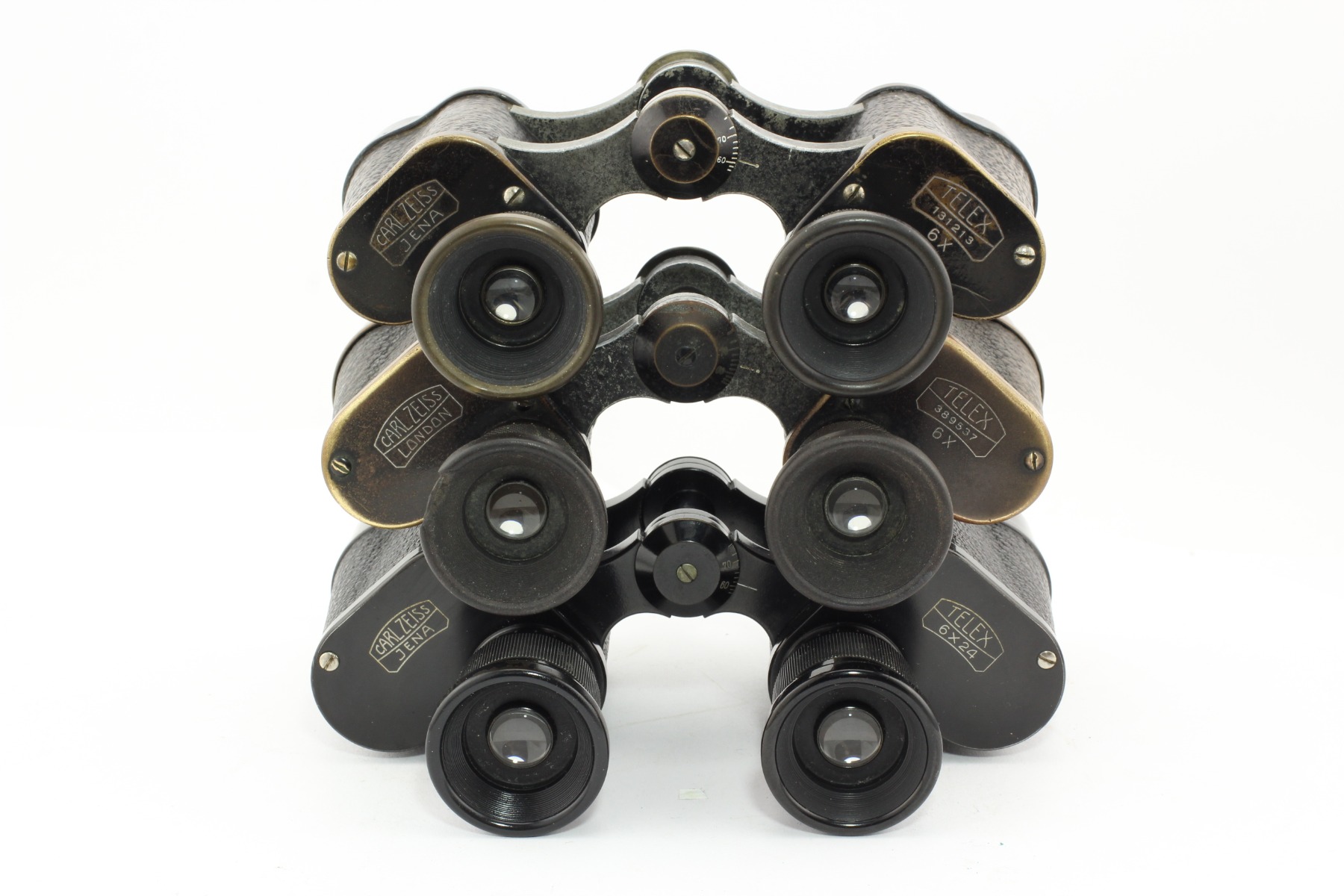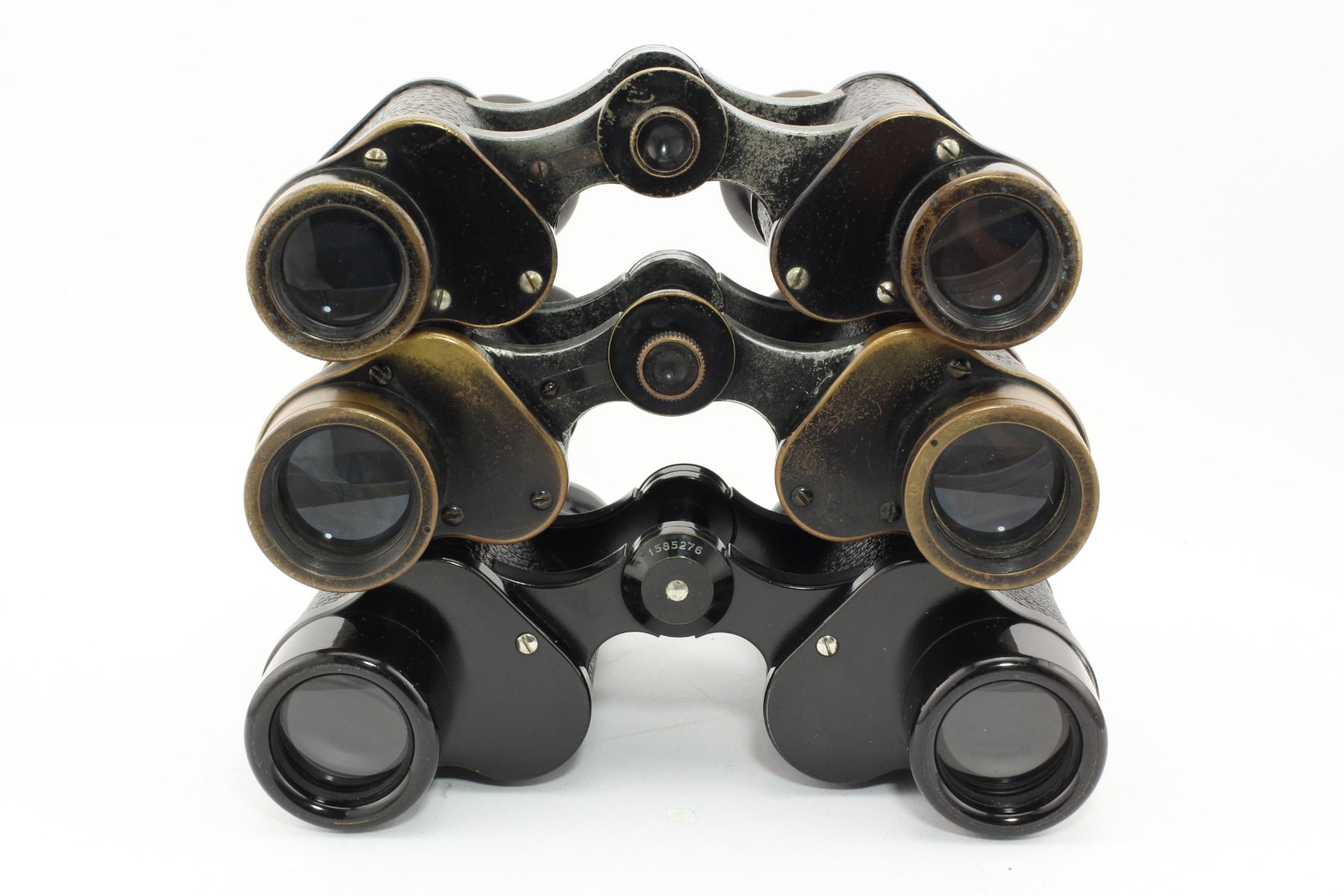Magnification: 6x
Aperture (objective diameter): 21 mm
Field of view: 6.8 °
Visible field of view (eyepiece): 41 °
Plasticity: 1.75
The closest focusing distance: 4.35 m
Width: 14.5 cm
Height: 10 cm
Weight: 430 g
Production date: 1907-1908.
Binoculars Carl Zeiss Wien Telex 6x
In 1907, Carl Zeiss radically changed the framework and the design of his binoculars, replacing "civilian" models Feldstecher 6 Fach by Telex, Feldstecher 8 Fach by Telact, Jagdglas by Silvamar and Feldstecher 12 Fach by Telefort. The new devices’ detailed characteristics were published in the 74-th volume of Carl Zeiss catalog in August 1907. However, there are facts indicating that the new models’ sale started a little bit earlier than this date.
The optical characteristics were significantly improved in new devices (the field of view and the objective diameter were increased, optical aberrations were decreased), and the devices’ design was also changed: the central hinge and the “lugs” for a neck strap were not attached to binocular with the help of screws any more, they became integral with it instead, an eccentric objective alignment system appeared and its frame design was also changed, the prism covers spanned the binoculars’ carcass, and they were lubricated with a special compound at the joint points in order to improve impermeability. Moreover, the prisms inside the binoculars were no longer pressed by prism covers – they were fixed with the help of special flat springs instead. It helped increasing the device’s reliability greatly. The serial numbers acquired continuous numbering, regardless of the model, and from then on they were placed on prismatic covers (on side surfaces, or on the upper right cover). Actually, the binoculars have survived in such appearance up to present days.
Telex is the smallest model with a new design, 6x magnification and 21mm lens in the very first version. It is a civilian model, however, there exist specimen with military features – the grid, large clamping screw, military numbering, etc. D.F.6 model is its military analogue.
The civilian application of this model is also proved by the central hinge fixture’s (clamp’s) small diameter (see photo), which has a hole for a knob (included to binoculars delivery kit), with the help of which the hinge could have been finally fixed depending on the observer’s interpupillary distance. The interpupillary distances scale is indicated on the upper hinge disk. Telex was produced in 4 versions with various design changes until 1932:
1st version: 6x21, in which the cap of frame lens and the lower prismatic cover were made as a single part (since 1907) and the eyepiece case had the “transverse” knurling (see photo)
2nd version: 6x21 with the two-ring type lens frames (since 1908/1909) https://binocollection.com/catalog/binocular-carl-zeiss-jena-telex-6x-2.html ;
3rd version: 6x24 with the two-ring type lens frames (since 1911/1912) http://binocollection.com/catalog/binoculars-carl-zeiss-london-telex-6x.html ;
4th version: 6x24 with the rounded lens covers (from 1913 to 1932) http://binocollection.com/catalog/binoculars-carl-zeiss-jena-telex-6x1.html ;




This device belongs to the 1st version in which the cap of frame lens and the lower prismatic cover were made as a single part. The grooves (knurling) are located perpendicularly to each other on the lenses (“transverse” knurling). The eyepieces possess the diopter scale for adjusting the acutance. The width of the upper prismatic cover is 42.5 mm; the binoculars height from the lower cut of lens frames to upper prismatic cover is equal to 65 mm. The eyepieces base diameter is equal to 20.5 mm.
The device was assembled in Vienna (the Carl Zeiss Jena affiliate, which was found in 1902 in Austria). Optical devices based on Carl Zeiss Jena components were assembled by this company until 1926.
There are inscriptions "Carl Zeiss Wien" on the left prism cover. There is also an inscription "Telex 2660 6x" on the right prism cover. The inscription is made in block letters against the background of Carl Zeiss Tessar photo lens schematic image (the earlier models had an inscription in italics until 1904). One more number, namely “2660”, is embossed on the side surface of the lower right prismatic cover. The four-digit serial number does not at all correspond to the generally accepted six-digit continuous numbering of Carl Zeiss binoculars of that time. This extremely interesting case is described in Hans T.Seeger’s book. Zeiss Handfernlaser 1919-1946, Modelle-Merkmale-Mythos, pages 478, 759): along with the general “continuous” numbering there also existed separate numbering, the algorithm of appearance of which has no explanation up to present days.
The lens frame and the lower prismatic cover are made as a single part, the eyepiece case has the “transverse” knurling: one may suppose that the device was produced no later than 1908.
The binocular with central focusing also appeared in 1910 – that was Telexem https://binocollection.com/catalog/binoculars-carl-zeiss-jena-telexem-6x.html .
Around 1935 Telex was replaced by the new model, namely by the Sportur.
The optical characteristics were significantly improved in new devices (the field of view and the objective diameter were increased, optical aberrations were decreased), and the devices’ design was also changed: the central hinge and the “lugs” for a neck strap were not attached to binocular with the help of screws any more, they became integral with it instead, an eccentric objective alignment system appeared and its frame design was also changed, the prism covers spanned the binoculars’ carcass, and they were lubricated with a special compound at the joint points in order to improve impermeability. Moreover, the prisms inside the binoculars were no longer pressed by prism covers – they were fixed with the help of special flat springs instead. It helped increasing the device’s reliability greatly. The serial numbers acquired continuous numbering, regardless of the model, and from then on they were placed on prismatic covers (on side surfaces, or on the upper right cover). Actually, the binoculars have survived in such appearance up to present days.
Telex is the smallest model with a new design, 6x magnification and 21mm lens in the very first version. It is a civilian model, however, there exist specimen with military features – the grid, large clamping screw, military numbering, etc. D.F.6 model is its military analogue.
The civilian application of this model is also proved by the central hinge fixture’s (clamp’s) small diameter (see photo), which has a hole for a knob (included to binoculars delivery kit), with the help of which the hinge could have been finally fixed depending on the observer’s interpupillary distance. The interpupillary distances scale is indicated on the upper hinge disk. Telex was produced in 4 versions with various design changes until 1932:
1st version: 6x21, in which the cap of frame lens and the lower prismatic cover were made as a single part (since 1907) and the eyepiece case had the “transverse” knurling (see photo)
2nd version: 6x21 with the two-ring type lens frames (since 1908/1909) https://binocollection.com/catalog/binocular-carl-zeiss-jena-telex-6x-2.html ;
3rd version: 6x24 with the two-ring type lens frames (since 1911/1912) http://binocollection.com/catalog/binoculars-carl-zeiss-london-telex-6x.html ;
4th version: 6x24 with the rounded lens covers (from 1913 to 1932) http://binocollection.com/catalog/binoculars-carl-zeiss-jena-telex-6x1.html ;
This device belongs to the 1st version in which the cap of frame lens and the lower prismatic cover were made as a single part. The grooves (knurling) are located perpendicularly to each other on the lenses (“transverse” knurling). The eyepieces possess the diopter scale for adjusting the acutance. The width of the upper prismatic cover is 42.5 mm; the binoculars height from the lower cut of lens frames to upper prismatic cover is equal to 65 mm. The eyepieces base diameter is equal to 20.5 mm.
The device was assembled in Vienna (the Carl Zeiss Jena affiliate, which was found in 1902 in Austria). Optical devices based on Carl Zeiss Jena components were assembled by this company until 1926.
There are inscriptions "Carl Zeiss Wien" on the left prism cover. There is also an inscription "Telex 2660 6x" on the right prism cover. The inscription is made in block letters against the background of Carl Zeiss Tessar photo lens schematic image (the earlier models had an inscription in italics until 1904). One more number, namely “2660”, is embossed on the side surface of the lower right prismatic cover. The four-digit serial number does not at all correspond to the generally accepted six-digit continuous numbering of Carl Zeiss binoculars of that time. This extremely interesting case is described in Hans T.Seeger’s book. Zeiss Handfernlaser 1919-1946, Modelle-Merkmale-Mythos, pages 478, 759): along with the general “continuous” numbering there also existed separate numbering, the algorithm of appearance of which has no explanation up to present days.
The lens frame and the lower prismatic cover are made as a single part, the eyepiece case has the “transverse” knurling: one may suppose that the device was produced no later than 1908.
The binocular with central focusing also appeared in 1910 – that was Telexem https://binocollection.com/catalog/binoculars-carl-zeiss-jena-telexem-6x.html .
Around 1935 Telex was replaced by the new model, namely by the Sportur.
